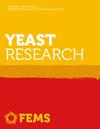酵母使苏格兰麦芽威士忌风味多样化的潜力
IF 2.4
4区 生物学
Q3 BIOTECHNOLOGY & APPLIED MICROBIOLOGY
引用次数: 0
摘要
苏格兰威士忌是苏格兰的重要产品,其独特品质源于法律规定的传统生产工艺,已获得全球认可。然而,持续不断的研究不断提高了苏格兰威士忌的生产水平,并促进了口味的多样化。要被归类为苏格兰威士忌,最终的酒必须保留 "苏格兰 "的香气和味道。从麦芽制备和糖化到发酵、蒸馏和熟化,每个生产步骤都对威士忌的风味有重要影响,而酵母在发酵过程中的影响则至关重要。酵母不仅能将糖分转化为酒精,还能产生重要的挥发性化合物,如酯类和高级醇类,这些都有助于形成威士忌的最终风味。威士忌发酵所选用的酵母会极大地影响威士忌的风味,因此所选用的酵母菌株非常重要。本综述探讨了酵母在苏格兰威士忌生产中的作用及其对风味多样化的影响。此外,还对酿造和葡萄酒酿造中使用的非常规酵母进行了广泛的研究,以评估其作为苏格兰威士忌酵母菌株的潜在适用性,随后还对评估新酵母菌株的方法进行了综述。本文章由计算机程序翻译,如有差异,请以英文原文为准。
The potential for scotch malt whisky flavour diversification by yeast
Scotch Whisky, a product of high importance to Scotland, has gained global approval for its distinctive qualities derived from the traditional production process which is defined in law. However, ongoing research continuously enhances Scotch Whisky production and is fostering a diversification of flavour profiles. To be classified as Scotch Whisky, the final spirit needs to retain the aroma and taste of “Scotch”. While each production step contributes significantly to whisky flavour—from malt preparation and mashing to fermentation, distillation, and maturation—the impact of yeast during fermentation is crucially important. Not only does the yeast convert the sugar to alcohol, it also produces important volatile compounds, for example esters and higher alcohols, that contribute to the final flavour profile of whisky. The yeast chosen for whisky fermentations can significantly influence whisky flavour, so the yeast strain employed is of high importance. This review explores the role of yeast in Scotch Whisky production and its influence on flavour diversification. Furthermore, an extensive examination of non-conventional yeasts employed in brewing and winemaking is undertaken to assess their potential suitability for adoption as Scotch Whisky yeast strains, followed by a review of methods for evaluating new yeast strains.
求助全文
通过发布文献求助,成功后即可免费获取论文全文。
去求助
来源期刊

FEMS yeast research
生物-生物工程与应用微生物
CiteScore
5.70
自引率
6.20%
发文量
54
审稿时长
1 months
期刊介绍:
FEMS Yeast Research offers efficient publication of high-quality original Research Articles, Mini-reviews, Letters to the Editor, Perspectives and Commentaries that express current opinions. The journal will select for publication only those manuscripts deemed to be of major relevance to the field and generally will not consider articles that are largely descriptive without insights on underlying mechanism or biology. Submissions on any yeast species are welcome provided they report results within the scope outlined below and are of significance to the yeast field.
 求助内容:
求助内容: 应助结果提醒方式:
应助结果提醒方式:


